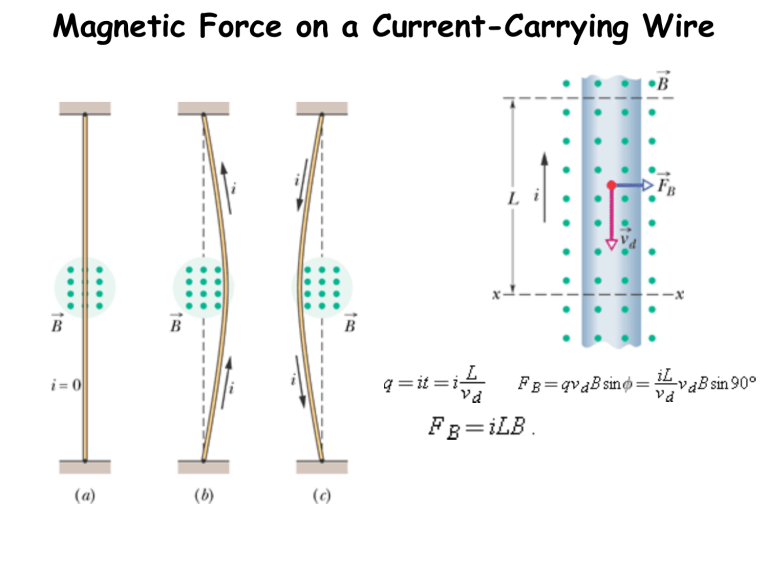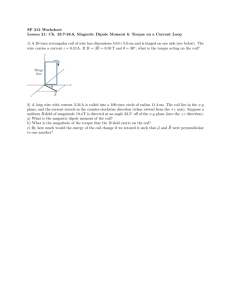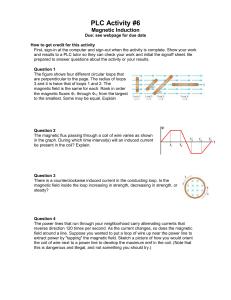Magnetic Force on a Current-Carrying Wire
advertisement

Magnetic Force on a Current-Carrying Wire Magnetic Force on a Current-Carrying Wire • If the magnetic field is not perpendicular to the wire, as in Fig, the magnetic force is given by Define as a length vector that has magnitude L and is directed along the wire segment in the direction of the (conventional) current. Check Your Understanding The same current-carrying wire is placed in the same magnetic field B in four different orientations (see the drawing). Rank the orientations according to the magnitude of the magnetic force exerted on the wire, largest to smallest. Sample Problem 28 A straight, horizontal length of copper wire has a current i=28 A through it. What are the magnitude and direction of the minimum magnetic field needed to suspend the wire—that is, to balance the gravitational force on it? The linear density (mass per unit length) of the wire is 46.6 g/m. Torque on a Current Loop Fnet 0 the vector , which is normal to the plane of the coil with direction determined by right hand rule shown in fig. (b). iAB sin A is area of loop When a current-carrying loop is placed in a magnetic field, the loop tends to rotate such that its normal becomes aligned with the magnetic field Torque on a Current coil A coil containing N loops, each of area A, the force on each side is N times larger, and the torque on the coil becomes: The Magnetic Dipole Moment of Coil • The direction of is that of the normal vector to the plane of the coil and thus is given by the same right-hand rule. That is, grasp the coil with the fingers of your right hand in the direction of current i; the outstretched thumb of that hand gives the direction of . • The magnitude of is given by N is the number of turns in the coil, i is the current through the coil, and A is the area enclosed by each turn of the coil. Magnetic Dipole in a Magnetic Field • The torque on the coil due to a magnetic field • The magnetic potential energy •If an applied torque to rotates a magnetic dipole from an initial orientation to another orientation , then work Wa is done on the dipole by the applied torque is Example The Torque Exerted on a CurrentCarrying Coil A coil of wire has an area of 2.0×10–4 m2, consists of 100 loops or turns, and contains a current of 0.045 A. The coil is placed in a uniform magnetic field of magnitude 0.15 T. (a) Determine the magnetic moment of the coil. (b) Find the maximum torque that the magnetic field can exert on the coil. A DC electric motor Conceptual Questions 1. A charged particle, passing through a certain region of space, has a velocity whose magnitude and direction remain constant. (a) If it is known that the external magnetic field is zero everywhere in this region, can you conclude that the external electric field is also zero? Explain. (b) If it is known that the external electric field is zero everywhere, can you conclude that the external magnetic field is also zero? Explain. 2. Suppose that the positive charge in Figure 21.10a were launched from the negative plate toward the positive plate, in a direction opposite to the electric field. A sufficiently strong electric field would prevent the charge from striking the positive plate. Suppose the positive charge in Figure 21.10b were launched from the south pole toward the north pole, in a direction opposite to the magnetic field. Would a sufficiently strong magnetic field prevent the charge from reaching the north pole? Account for your answer. 3. Three particles move through a constant magnetic field and follow the paths shown in the drawing. Determine whether each particle is positively charged, negatively charged, or neutral. Give a reason for each answer. 4. When one end of a bar magnet is placed near a TV screen, the picture becomes distorted. Why? 5. A positive charge moves along a circular path under the influence of a magnetic field. The magnetic field is perpendicular to the plane of the circle, as in Figure 21.12. If the velocity of the particle is reversed at some point along the path, will the particle retrace its path? If not, draw the new path. Explain.




